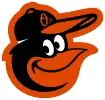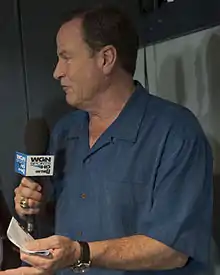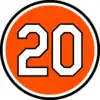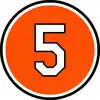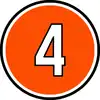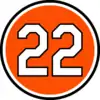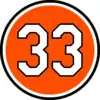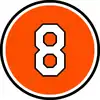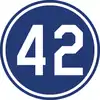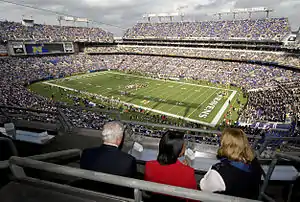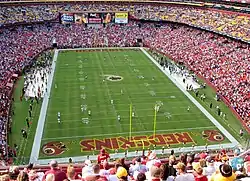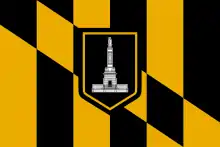Baltimore Orioles
The Baltimore Orioles are an American professional baseball team based in Baltimore, Maryland. The Orioles compete in Major League Baseball (MLB) as a member club of the American League (AL) East division. As one of the American League's eight charter teams in 1901, this particular franchise spent its first year as a major league club in Milwaukee, Wisconsin, as the Milwaukee Brewers before moving to St. Louis, Missouri, to become the St. Louis Browns in 1902. After 52 years in St. Louis, the franchise was purchased in November 1953 by a syndicate of Baltimore business and civic interests led by attorney and civic activist Clarence Miles and Mayor Thomas D'Alesandro Jr. The team's current owner is American trial lawyer Peter Angelos.
| Baltimore Orioles | |||
|---|---|---|---|
| Established in 1901 | |||
| Based in Baltimore since 1954 | |||
| |||
| Major league affiliations | |||
| |||
| Current uniform | |||
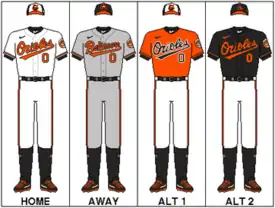 | |||
| Retired numbers | |||
| Colors | |||
| Name | |||
| |||
| Other nicknames | |||
| |||
| Ballpark | |||
| |||
| Major league titles | |||
| World Series titles (3) | |||
| AL Pennants (7) | |||
| East Division titles (9) | |||
| Wild card berths (3) | |||
| Front office | |||
| Principal owner(s) | Peter Angelos | ||
| General manager | Mike Elias | ||
| Manager | Brandon Hyde | ||
The Orioles adopted their team name in honor of the official state bird of Maryland; it had also been used by several previous major and minor league baseball clubs in Baltimore, including another AL charter member franchise also named the "Baltimore Orioles", which moved north in 1903 to eventually become the New York Yankees. Nicknames for the team include the "O's" and the "Birds".
The Orioles experienced their greatest success from 1966 to 1983, when they made six World Series appearances, winning three of them (1966, 1970, 1983). This era of the club featured several future Hall of Famers who would later be inducted representing the Orioles, such as third baseman Brooks Robinson, outfielder Frank Robinson, starting pitcher Jim Palmer, first baseman Eddie Murray, shortstop Cal Ripken Jr., and manager Earl Weaver. The Orioles have won a total of nine division championships (1969–1971, 1973–1974, 1979, 1983, 1997, 2014), six pennants (1966, 1969–1971, 1979, 1983), and three wild card berths (1996, 2012, 2016).
After suffering a stretch of 14 straight losing seasons from 1998 to 2011, the team qualified for the postseason three times under manager Buck Showalter and general manager Dan Duquette, including a division title and advancement to the American League Championship Series for the first time in 17 years in 2014. However the 2018 team lost 115 games,[5] prompting the team to move on from Showalter and Duquette following the season's conclusion. The Orioles' current manager is Brandon Hyde, while Mike Elias serves as general manager and executive vice president.
The Orioles are also well known for their influential ballpark, Oriole Park at Camden Yards, which opened in 1992 in downtown Baltimore.[6][7]
From 1901 through the end of 2020, the franchise's overall win-loss record is 8793-9763 (a 0.474 win-loss percentage). Since moving to Baltimore in 1954, the Orioles have an overall win-loss record of 5331-5209 (a .506 win-loss percentage) through the end of 2020.[8]
History
The modern Orioles franchise can trace its roots back to the original Milwaukee Brewers of the minor Western League, beginning in 1877, when the league reorganized. The Brewers were there when the Western League renamed itself the American League in 1900.
Milwaukee Brewers (1901)
At the end of the 1900 season, the American League removed itself from baseball's National Agreement (the formal understanding between the NL and the minor leagues). Two months later, the AL declared itself a competing major league. As a result of several franchise shifts, the Brewers were one of only two Western League teams that didn't fold, move or get kicked out of the league (the other being the Detroit Tigers). In its first game in the American League, the team lost to the Detroit Tigers 14–13 after surrendering a nine-run lead in the 9th inning.[9] To this day, it is a major league record for the biggest deficit overcome that late in the game.[10] In the first American League season in 1901, they finished last (eighth place) with a record of 48–89. Its lone Major League season, the team played at Lloyd Street Grounds, between 16th and 18th Streets in Milwaukee.
St. Louis Browns (1902–1953)
After one year in Milwaukee, the club relocated to St Louis, and for a while enjoyed some success, especially in the 1920s behind Hall of Fame first baseman George Sisler. However, the team's fortunes declined from then on, as playing success and gate receipts instead went increasingly to the Browns' own tenants at Sportsman's Park, the National League Cardinals. During this period the Browns won only one pennant, in the 1944 season stocked with wartime replacement players, and lost to the Cardinals in the third and last World Series ever played entirely in one ballpark. In 1953, with the Browns unable to afford even stadium upkeep, owner Bill Veeck sold Sportsman's Park to the Cardinals and attempted to move the club back to Milwaukee, but this was vetoed by the other American League owners. Instead, Veeck sold his franchise to a partnership of Baltimore businessmen. Because Veeck was unpopular with fellow American League owners, his leaving baseball was a condition for the AL owners to approve the move.[11][12]
Baltimore Orioles (1954–present)
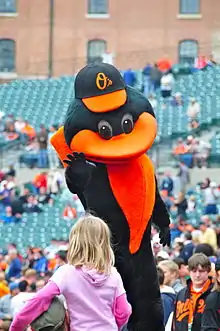
The Miles-Krieger (Gunther Brewing Company)-Hoffberger group renamed their new team the Baltimore Orioles soon after taking control of the franchise. The name has a rich history in Baltimore, having been used by a National League team in the 1890s. In 1901, Baltimore and John McGraw were awarded an expansion franchise in the growing American League, naming the team the Orioles. After a battle with Ban Johnson, the Head of the American League in 1902, McGraw took many of the top players including Walter Scott "Steve" Brodie, Dan McGann, Roger Bresnahan, and Joe McGinnity to the New York Giants. As an affront to Johnson, McGraw kept the black and orange colors of the New York Giants, which San Francisco wears to this day. In 1903, the franchise—the remaining players, assets and debts, the corporation—was transferred to New York where they were nicknamed the Highlanders until circa 1912, by which time Yanks or Yankees had taken over as their popular moniker. As a member of the high-minor league level International League, the Orioles competed at what is now known as the AAA level from 1903 to 1953; the IL Orioles' most famous player was a local Baltimore product, hard-hitting left-handed pitcher Babe Ruth. When Oriole Park burned down in 1944, the team moved to a temporary home, Municipal Stadium, where they won the Junior World Series. Their large postseason crowds caught the attention of the major leagues, eventually leading to a new MLB franchise in Baltimore.[14]
Seeds of success (1954–1959)
After starting the 1954 campaign with a two-game split against the Tigers in Detroit, the Orioles returned to Baltimore on April 15 to a welcoming parade that wound through the streets of downtown, with an estimated 350,000 spectators lining the route. In its first-ever home opener at Memorial Stadium later in the afternoon, they treated a sellout crowd of 46,354 to a 3–1 victory over the Chicago White Sox. The remainder of the season would not be as pleasant, with the team enduring 100 losses while avoiding the AL cellar by only three games. With fellow investors both frustrated with his domination of the franchise's business operations and dissatisfied with yet another seventh-place finish, Clarence Miles resigned in early November 1955. Real estate developer James Keelty Jr. succeeded him as president with investment banker Joseph Iglehart the new board chairman.
The seeds of long-term success were planted on September 14, 1954, when the Orioles hired Paul Richards to become the ballclub's manager and general manager. He laid the foundation for what would years later be called the Oriole Way. The instruction of baseball fundamentals became uniform in every detail between all classes within the organization. Players were patiently refined until fundamentally sound instead of being hastily advanced to the next level.
For the remainder of the 1950s, the Orioles crawled up the standings, reaching as high as fifth place with a 76–76 record in 1957. Richards succeeded in stocking the franchise with a plethora of young talent which included Dave Nicholson, Pete Ward, Ron Hansen (1960 AL Rookie of the Year), Milt Pappas, Jerry Adair, Steve Barber (20 wins in 1963), Boog Powell, Dave McNally, and Brooks Robinson. Unfortunately, Richards also had the tendency to recklessly spend money on individuals with dubious baseball skills. This became a major problem as bidding wars between the ballclubs to land the best amateur players escalated signing bonuses.
The solution came on November 5, 1958, when Lee MacPhail was appointed general manager, allowing Richards to focus on his managerial duties. MacPhail added much-needed discipline to the scouting staff by establishing cross-checkers who thoroughly evaluated young hopefuls to determine whether they were worthy of being tendered a contract. He also accepted the title of president after Keelty resigned in mid-December 1959.
Pennant contenders (1960–1965)
One month prior to the end of the 1961 season, Richards resigned as the team's skipper to become the general manager of the expansion Houston Colt .45s. A year earlier, he succeeded in establishing the Orioles as a legitimate contender when they stood atop the AL standings as late as early September before finishing in second place at 89–65.
In 1964, the Birds, piloted by Hank Bauer in his first year of managing the ballclub, were involved in a tight pennant race against the Yankees and White Sox. They ended up in third place with a 97–65 record, only two games out. It has been suggested they would likely have advanced to the Fall Classic had it not been for a minor wrist injury that sidelined Powell for two weeks in late August.[15] Nevertheless, Brooks Robinson enjoyed a breakout season with a league-high 118 RBIs, and won the AL Most Valuable Player Award.
The television/radio network of CBS' purchase of a majority stake in the Yankees on September 9 of that same year resulted in a change to the ownership situation in Baltimore. Iglehart, the Orioles' largest shareholder at 32% and owner of a sizable amount of CBS stock, straightened out his conflict of interest issues on May 25, 1965, by selling his 64,000 shares in the ball-club to the National Brewing Company, an original team investor which finally had controlling interest at 65%. Brewery president Jerold Hoffberger became the Orioles' new chairman of the board. Hoffberger's first action was installing Frank Cashen, the Director of Advertising for the National Brewery, as Senior Vice President & Chief Operating Officer for the Orioles.
With the benefit of a deep talent pool and superior scouts, the franchise continued to make improvements at the major league level. Three months before the start of the 1963 season, the Orioles stabilized its infield by acquiring Luis Aparicio in a transaction that involved sending a trio of homegrown players (Hansen, Nicholson and Ward) to the White Sox. They also scoured the minor leagues for selections in the Rule 5 draft (Paul Blair from the Mets in 1962, Moe Drabowsky from the Cardinals in 1965) and claims off waivers (Curt Blefary, 1965 AL Rookie of the Year, from the Yankees in 1963).
Milt Pappas for Frank Robinson

On December 9, 1965, the Orioles traded pitcher Milt Pappas (and several others) to the Cincinnati Reds in exchange for slugging outfielder Frank Robinson. The following year, Robinson won the American League Most Valuable Player award, thus becoming the first (and so far only) man to win the MVP in each league (Robinson won the NL MVP in 1961, leading the Reds to the pennant). In addition to winning the 1966 MVP, Robinson also won the Triple Crown (leading the American League in batting average, home runs, and runs batted in), a feat also achieved the following season by Boston's Carl Yastrzemski. The Orioles won their first-ever American League championship in 1966, and in a major upset, swept the World Series by out-dueling the defending World Champion Los Angeles Dodgers, whose pitching staff was led by aces Sandy Koufax and Don Drysdale. The only home run ball ever hit completely out of Memorial Stadium was slugged by Robinson on Mother's Day in 1966, off Cleveland Indians pitcher Luis Tiant. It cleared the left field single-deck portion of the grandstand. A flag was later erected near the spot the ball cleared the back wall, with simply the word "HERE" upon it. The flag is now in the Baltimore Orioles Museum.
Pappas went 30–29 in a little over two years with the Reds before he was traded. Although he would go on to have back-to-back 17-win seasons for the Chicago Cubs in 1971 and 1972, including a no-hitter in the latter season, this did not help the Reds, who ended up losing the 1970 World Series to Robinson and the Orioles. This trade has become renowned as one of the most lopsided in baseball history, including a mention by Susan Sarandon in her opening soliloquy in the 1988 film Bull Durham: "Bad trades are a part of baseball. I mean, who can forget Frank Robinson for Milt Pappas?"[16]
Glory years (1966–1983)
In the 1960s, the Orioles farm system produced an especially large number of high-quality players and coaches and laid the foundation for two decades of on-field success. This period included eighteen consecutive winning seasons (1968–1985) – a run of success that saw the Orioles become the envy of the league, and the winningest team in baseball.
During this period, the Orioles played baseball the "Oriole Way", an organizational ethic best described by longtime farm hand and coach Cal Ripken Sr.'s phrase "perfect practice makes perfect!" The Oriole Way was a belief that hard work, professionalism, and a strong understanding of fundamentals were the keys to success at the major league level. It was based on the belief that if every coach, at every level, taught the game the same way, the organization could produce "replacement parts" that could be substituted seamlessly into the big league club with little or no adjustment. Elaborations on the Oriole way include pitching coach and manager Ray Miller's maxim "Work fast, change speeds, and throw strikes" and manager Earl Weaver's maxim "Pitching, defense and three-run homers."
The "Oriole Way" began flourishing in 1966 after the Robinson-for-Pappas deal, as Robinson won the "Triple Crown Award". His Orioles would easily sweep the Los Angeles Dodgers in the 1966 World Series. After a mediocre 1967 season, Hank Bauer would be replaced by Earl Weaver halfway into 1968. The Orioles would finish second in the American League. This would only be a prelude to 1969, when the Orioles won 109 games and easily won the newly created American League East division title. Mike Cuellar shared the Cy Young Award with Detroit's Denny McLain. After sweeping Minnesota in the American League Championship Series, Baltimore was shocked by losing to the New York Mets in a five-game World Series. The next year, Boog Powell won the MVP and the Orioles won another 108 games. After sweeping the Twins once again in the ALCS, the Orioles won the 1970 World Series by defeating the Cincinnati Reds' Big Red Machine in five games.
In 1971, the Orioles won another division title thanks to four 20-game winners on their pitching staff (Cuellar, Jim Palmer, Pat Dobson, and Dave McNally). After defeating the young Oakland A's in the ALCS, the Orioles would lose a heartbreaking seven-game World Series to the Pittsburgh Pirates. The Orioles would miss the playoffs in 1972, but rebounded to win the division in 1973 and 1974. Each time, they would lose to Oakland in the ALCS. During this stretch, the Orioles began to phase out their veteran infield by replacing Davey Johnson and Brooks Robinson with younger stars Bobby Grich and Doug DeCinces, respectively. Johnson would be dealt along with Johnny Oates to the Atlanta Braves for catcher and 1971 National League Rookie of the Year Earl Williams. Although Williams had hit 63 home runs in two seasons with Atlanta, he would hit only 36 homers in two seasons with the Orioles.
In 1975, the Birds acquired slugger Lee May in a trade with Houston, and traded Dave McNally, Rich Coggins and minor-league pitcher Bill Kirkpatrick to Montreal for star outfielder Ken Singleton, and future 20-game winner Mike Torrez. Jim Palmer won the Cy Young Award, but the Orioles lost the division title to the Boston Red Sox and their mega-rookies Fred Lynn and Jim Rice. The 1976 season brought Reggie Jackson and Ken Holtzman from a trade with Oakland, but the Orioles only won 88 games. It was this season when the Orioles made a trade that brought them players such as Tippy Martinez and Rick Dempsey. This young foundation, along with the departures of the unhappy Jackson and Holtzman, would create the basis for 1977. The "No Name Orioles", along with Rookie of the Year Eddie Murray, won 97 games and finished tied for second place with Boston. After finishing fourth in 1978, the Orioles finally won the division in 1979 thanks to strong play from Ken Singleton and Cy Young winner Mike Flanagan. The Orioles defeated the Angels in the ALCS, but lost to Pittsburgh in another stunning World Series. This started a short period of heartbreak for Baltimore which would nevertheless culminate in a championship.
The Orioles won 100 games in 1980 thanks to Cy Young winner Steve Stone who went 25–7 (.781) while leading the league in wins (a franchise record) and win-loss percentage, but the Yankees won 103 games. Although Baltimore had the best overall record in the AL East in 1981, they finished second in each half. As a result, they were out of the playoffs due to the postseason structure that year because of the strike. The 1982 campaign saw Baltimore eliminated on the final weekend of the season by the Milwaukee Brewers. In an unforgettable scene, despite the season-ending loss eliminating them from the playoffs, fans stayed to honor the retiring Earl Weaver, who would be succeeded by Joe Altobelli. In 1983, Altobelli would lead the Orioles to 98 wins and a division title thanks to MVP Cal Ripken Jr.. The Orioles defeated the Chicago White Sox in the ALCS thanks to a 10th-inning homer by Tito Landrum in the deciding game. The Orioles won the World Series in five games by defeating the Philadelphia Phillies.
During their most productive years and only World Series championships thus far, the Orioles saw three of its players named MVP: Frank Robinson in 1966; Boog Powell in 1970; and Cal Ripken Jr. in 1983. Additionally, Brooks Robinson was named Most Valuable Player in 1964, just two years before the 1966–1983 golden era began. The pitching staff was phenomenal, with four pitchers winning six Cy Young Awards (Mike Cuellar in 1969; Jim Palmer in 1973, 1975, and 1976; Mike Flanagan in 1979; and Steve Stone in 1980). In 1971, the team's four starting pitchers, McNally, Cuellar, Palmer, and Pat Dobson, all won 20 games, a feat that has not been replicated. In that year, the Birds went on to post a 101–61 record for their third-straight AL East title.[17] Also during this stretch three players were named rookies of the year: Al Bumbry (1973); Eddie Murray (1977); and Cal Ripken Jr. (1982). One might date the glory years of the Orioles dating back to 1964, which would include two third-place seasons, 1964–65, in which the Orioles won 97 and 94 games, respectively, and a year in which third-baseman Brooks Robinson won his Most Valuable Player Award (1964). The glory years of the Orioles effectively ended when the Detroit Tigers, a divisional rival at the time, went 35–5 to open the 1984 season on the way to winning the World Series, in which Hall-of-Fame pitcher Jim Palmer retired during the 1984 season.
Final seasons at Memorial Stadium (1984–1991)
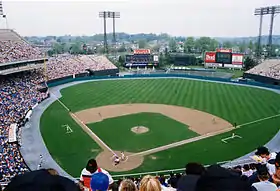
After winning the 1983 World Series, the Orioles spent the next five years in steady decline, finishing 1986 in last place for the first time since the franchise moved to Baltimore. The team hit bottom in 1988 when it started the season 0–21, en route to 107 losses and the worst record in the majors that year. The "Why Not?" Orioles surprised the baseball world the following year by spending most of the summer in first place until September when the Toronto Blue Jays overtook them and seized the AL East title on the final weekend of the regular season. The next two years were spent below the .500 mark, highlighted only by Cal Ripken Jr. winning his second AL MVP Award in 1991. The Orioles said goodbye to Memorial Stadium, the team's home for 38 years, at the end of the 1991 campaign.

Camden Yards opens (1992–1993)
Opening to much fanfare in 1992, Oriole Park at Camden Yards was an instant success, spawning other retro-designed major league ballparks within the next two decades. The stadium became the site of the 1993 All-Star Game. The Orioles returned to contention in those first two seasons at Camden Yards, only to finish in third place both times.
Angelos takes over
Also in 1993, with then-owner Eli Jacobs forced to divest himself of the franchise, Baltimore-based attorney Peter Angelos, along with the ownership syndicate he headed, was awarded the Orioles in bankruptcy court in New York City, returning the team to local ownership for the first time since 1979.
Strike year (1994)
After the 1993 season, the Orioles acquired first baseman Rafael Palmeiro from the Texas Rangers. The Orioles, who spent all of 1994 chasing the New York Yankees, occupied second place in the new five-team AL East when the players strike, which began on August 11, forced the eventual cancellation of the season.
Ripken breaks the streak (1995)
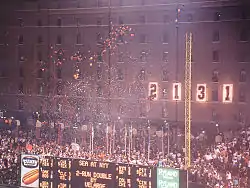
The labor impasse would continue into the spring of 1995. Almost all the major league clubs held spring training using replacement players, with the intention of beginning the season with them. The Orioles, whose owner was a labor union lawyer, were the lone dissenters against creating an ersatz team, choosing instead to sit out spring training and possibly the entire season. Had they fielded a substitute team, Cal Ripken Jr.'s consecutive games streak would have been jeopardized. The replacements questions became moot when the strike was finally settled.
The Ripken countdown resumed once the season began. Ripken finally broke Lou Gehrig's consecutive games streak of 2,130 games in a nationally televised game on September 6. This was later voted the all-time baseball moment of the 20th century by fans from around the country in 1999. Ripken finished his streak with 2,632 straight games, finally sitting on September 20, 1998, the Orioles final home game of the season against the Yankees at Camden Yards.
The Orioles finished two games under .500 (71–73) in third place in Phil Regan's only season of managing the ballclub.
1996 season
Before the 1996 season, Angelos hired Pat Gillick as general manager. Given the green light to spend heavily on established talent, Gillick signed several premium players like B. J. Surhoff, Randy Myers, David Wells and Roberto Alomar. Under new manager Davey Johnson and on the strength of a then-major league record 257 home runs in a single season, the Orioles returned to the playoffs after a 12-year absence by clinching the AL wild card berth. Alomar set off a firestorm in September when he spat into home plate umpire John Hirschbeck's face during an argument in Toronto. He was later suspended for the first five games of the 1997 season, even though most wanted him banned from the postseason. After dethroning the defending American League champion Cleveland Indians 3–1 in the Division Series, the Orioles fell to the Yankees 4–1 in an ALCS notable for right field umpire Rich Garcia's failure to call fan interference in the first game of the series, when 12-year-old Yankee fan Jeffrey Maier reached over the outfield wall to catch an in-play ball, which was scored as a home run for Derek Jeter, tying the game at 4–4 in the eighth inning. Absent Maier's interference, it appeared as if the ball might have been off the wall or caught by right fielder Tony Tarasco. The Yankees went on to win the game in extra innings on an ensuing walk-off home run by Bernie Williams.
1997 season
The Orioles went "wire-to-wire" (first place from start to finish) in winning the AL East title in 1997. After eliminating the Seattle Mariners 3–1 in the Division Series, the team lost again in the ALCS, this time to the underdog Indians 4–2, with each Oriole loss by only a run. Johnson resigned as manager after the season, largely due to a spat with Angelos concerning Alomar's fine for missing a team function being donated to Johnson's wife's charity.[18] Pitching coach Ray Miller replaced Johnson.
1998 season
With Miller at the helm, the Orioles found themselves not only out of the playoffs, but also with a losing season. When Gillick's contract expired in 1998, it was not renewed. Angelos brought in Frank Wren to take over as GM. The Orioles added volatile slugger Albert Belle, but the team's woes continued in the 1999 season, with stars like Rafael Palmeiro, Roberto Alomar, and Eric Davis leaving in free agency. After a second straight losing season, Angelos fired both Miller and Wren. He named Syd Thrift the new GM and brought in former Cleveland manager Mike Hargrove.
1999 season
In a rare event on March 28, 1999, the Orioles staged an exhibition series against the Cuban national team in Havana. The Orioles won the game 3–2 in 11 innings. They were the first Major League team to play in Cuba since 1959, when the Los Angeles Dodgers faced the Orioles in an exhibition. The Cuban team visited Baltimore in May 1999. Cuba won the second game 10–6.
2000–2001 seasons: Ripken retires
Cal Ripken Jr. achieved his 3000th hit early in the season. A fire sale occurred late in the season, where the Orioles traded away many veterans for unproven young players and minor league prospects. The Orioles called up many of their AAA players to finish the season. The only acquired player who would have a long-term career with the organization was Melvin Mora.
This was Cal Ripken Jr.'s final season. His number (8) was retired in a ceremony before the final home game of the season.
2002–2004 seasons

The team's first year without Ripken saw the team with a record of 63–63 at the conclusion of play on August 23, but then proceed to lose 32 of its last 36 games of the season, including their final 12 in a row to finish the season 67–95. In an effort to right the Orioles' sinking ship, changes began to sweep through the organization in 2003. General manager Syd Thrift was fired and to replace him, the Orioles hired Jim Beattie as executive vice-president and Mike Flanagan as the vice president of baseball operations. After another losing season, manager Mike Hargrove was not retained and Yankees coach Lee Mazzilli was brought in as the new manager. The team signed powerful hitters in SS Miguel Tejada, C Javy López, and former Oriole 1B Rafael Palmeiro. The following season, the Orioles traded for OF Sammy Sosa.
2005 season

The team got hot early in 2005 and jumped out in front of the AL East division, holding onto first place for 62 straight days. However, turmoil on and off the field began to take its toll as the Orioles started struggling around the All-Star break, dropping them close to the surging Yankees and Red Sox. Injuries to Lopez, Sosa, Luis Matos, Brian Roberts, and Larry Bigbie came within weeks of each other, and the team grew increasingly dissatisfied with the "band-aid" moves of the front office and manager Mazzilli to help them through this period of struggle. Various minor league players such as Single-A Frederick OF Jeff Fiorentino were brought up in place of more experienced players such as OF David Newhan, who had batted .311 the previous season.
After starting the season 42–28 (.600), the Orioles finished the season with a stretch of 32–60 (.348), ending at 74–88 (.457). Only the Kansas City Royals (.346) had a worse winning percentage for the season than did the Orioles for the final 92 games. The club's major off-season acquisition, Sammy Sosa, posted his worst performance in a decade, with 14 home runs and a .221 batting average. The Orioles did not attempt to re-sign him. The Orioles also allowed Palmeiro to file for free agency and publicly stated they would not re-sign him. On August 25, pitcher Sidney Ponson was arrested for DUI, and on September 1, the Orioles moved to void his contract (on a morals clause) and released him. The Major League Baseball Players Association filed a grievance on Ponson's behalf and the case was sent to arbitration and was eventually resolved.
2006 season
In the 2006 World Baseball Classic, the Orioles contributed more players than any other major league team, with eleven players suiting up for their home nations. Érik Bédard and Adam Loewen pitched for Canada; Rodrigo López and Gerónimo Gil (released before the season began by the club) played for Mexico; Daniel Cabrera and Miguel Tejada for the Dominican Republic; Javy López and Luis Matos for Puerto Rico; Bruce Chen for Panama; Ramón Hernández for Venezuela; and John Stephens for Australia. The Orioles finished the 2006 season with a record of 70 wins and 92 losses, 27 games behind the AL East-leading Yankees.
2007 season
On June 18, the Orioles fired Sam Perlozzo after losing eight straight games. He was replaced on interim basis by Dave Trembley. On June 22, Miguel Tejada's consecutive-games streak came to an end due to an injury, the fifth-longest streak in major league history. Aubrey Huff became the first Oriole to hit for the cycle at home, on June 29 against the Angels. On July 7, Érik Bédard struck out 15 batters in a game against the Texas Rangers to tie a franchise record held by Mike Mussina. On July 31, 2007, Andy MacPhail named Dave Trembley as the Orioles manager through the remainder of the 2007 season, and advised him to "Keep up the good work."[19] Facing the Texas Rangers in a doubleheader at Camden Yards on August 22, the Orioles surrendered 30 runs in the first game, a modern-era record for a single game, in a 30–3 defeat. The Orioles led the game 3–0 after three innings of play. Sixteen of Texas' thirty runs were scored in the final two innings. The Orioles would also fall in the nightcap, 9–7.
2008 season
The Orioles began the 2008 season in a rebuilding mode under President of Baseball Operations Andy MacPhail. The Orioles traded away star players Miguel Tejada to the Astros and ace Érik Bédard to the Seattle Mariners for prized prospect Adam Jones, lefty reliever George Sherrill, and minor league pitchers Kam Mickolio, Chris Tillman, and Tony Butler. The Orioles started off the first couple weeks of the season near the top of their division as players such as Nick Markakis and newcomer Luke Scott led the team offensively. Although the Orioles hovered around .500 for much of the season, they had fallen back by September and were over 20 games behind the first place Tampa Bay Rays. They finished the season losing 11 of their final 12 games and 28 of their final 34. The team finished last for the first time since their 1988 season.
After the season ended, the Orioles showcased altered uniforms, with a circular 'Maryland' patch added to the left-hand sleeve of all jerseys and the grey road jerseys displaying "Baltimore" across the chest for the first time in a quarter-century; this reflected the arrival of the Washington Nationals, because ever since the Washington Senators had departed for Texas in 1972, the Orioles had claimed to represent the Baltimore-Washington metro area.
2009 season

On June 30, the Orioles rallied to score 10 runs against Boston Red Sox after facing a 10–1 deficit in the 7th inning, winning the game by 11–10, setting a Major League Baseball record for the largest comeback by a last-place team over a first-place team.[20] However, the team finished the 2009 season with 64 wins and 98 losses, making it the worst record in the 2009 American League season. Despite this, Manager Dave Trembley was re-hired for the 2010 season.[21] Centerfielder Adam Jones was named to the 2009 All Star team, and awarded a Gold Glove award for his defensive play.
2010 season
On April 12, the team set a club record for the lowest paid attendance in Camden Yards history, only 9,129 attended the game versus the Tampa Bay Rays.[22] The Orioles then went 2–16 to begin the season, last in the league by quite a margin.[23]
On June 4, with an 8-game losing streak and the worst record in the league at 15–39, the Orioles replaced Dave Trembley as manager with third base coach Juan Samuel as interim manager.[24] They did well at first, but then they started losing again, going 17–34 under Samuel.[25] The Orioles hired Buck Showalter on July 29 to be the full-time manager.[26] He was introduced on August 2 and made his debut on August 3, after the Orioles fired Samuel. Showalter's arrival produced, or coincided with, a turnaround; the Birds went 34–23 under Showalter to finish 66–96.[25]
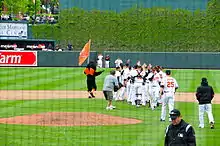
2011 season
On February 4, 2011, the Orioles signed free agent Vladimir Guerrero to be the team's designated hitter. Playing for the Texas Rangers during the 2010 season, Guerrero had hit 29 home runs, with a .300 batting average. (His career batting average was .320 with 436 home runs.)
The Orioles 2011 record was 69–93, the 14th consecutive losing season for the franchise dating back to 1998. The highlight of the season was their final game on September 28, when they defeated the Boston Red Sox 4–3 thanks to 9th inning heroics by Nolan Reimold and Robert Andino. The Orioles victory prevented the Red Sox from earning the wild card berth as part of "Game 162", one of the most dramatic nights in Major League Baseball history. On November 8, the Orioles announced the hiring of Dan Duquette as the vice president of baseball operations (de facto GM) in the hopes of turning the corner.
2012 season
The Orioles finished the first half of the 2012 season with a winning record for only the second time since going wire to wire in 1997, with a record of 45–40 before the All-Star break. On May 6, the Orioles played a 17-inning game against the Boston Red Sox, the first game since 1925 in which both teams used a position player as a pitcher. The Orioles won that game, and designated hitter Chris Davis received the win. The Orioles won their 81st game on September 13, ending the streak of 14 straight years with a losing record, as well as ensuring the team would spend the entire year with a record of .500 or higher. On September 16, they won their 82nd game, securing the first season with a winning record since 1997.
On September 21, closer Jim Johnson earned his 46th save of the season, setting a new Orioles franchise record for saves by one pitcher in a single season. It was previously held by Randy Myers, who had 45 saves in 1997. Johnson became the tenth player to record 50 saves in Major League history. He finished the regular season with 51 saves.
With the win against the Boston Red Sox on September 30 and the loss of the Los Angeles Angels to the Texas Rangers in the second game of a doubleheader, the Orioles clinched a playoff berth. This season marked the Orioles return to postseason play.
The Orioles finished the regular season in second place in the AL East with a record of 93–69, reversing the 69–93 record from the previous year. Despite a poor run differential (+7, the lowest of all playoff teams in 2012), they benefited from a 29–9 record in games decided by one run and a 16–2 record in extra-inning games. They went on the road to face the team that finished first in the Wild Card race, the Texas Rangers for a one-game playoff series on October 5, winning 5–1 to advance to the ALDS against the New York Yankees on October 7.
The season was also distinctive for the fact that Orioles became the only team in MLB history, since 1900, never to have lost a game due to an opponent's walk-off hit.[27] Despite a regular season of avoiding walk-off losses, they lost in Game 3 of the ALDS when Yankee Raúl Ibañez hit his own record-setting, game-winning home run in the bottom of the 12th inning. The Orioles would lose the 2012 ALDS in five games.
2013 season
During the home opener on April 5, first baseman Chris Davis set a new MLB record with 16 RBI's during the first four games of a season, as well as becoming the fourth player ever to hit home runs in the first four games, including a grand slam in the fourth. On September 13, Davis hit his 50th home run of the season, against the Toronto Blue Jays, tying Brady Anderson for the most home runs in Orioles history. Davis would break Anderson's record four days later against the Boston Red Sox. His 51st home run also tied Anderson's record of 92 extra-base hits in a single season, a record he would again break four days later. Davis would go on to finish the season with 53 home runs.
On September 18, the Orioles played their 114th errorless game of the season, setting a new MLB record for the most errorless games in one season since 1900.[28] They played 119 games without an error, ending on September 27.
On September 20, the Orioles played the Tampa Bay Rays in an 18 inning game that lasted 6 hours, 54 minutes, a new record for the longest game in terms of time for both franchises, as well as innings for the Rays. The Rays won 5–4.
While the Orioles would ultimately miss the playoffs in 2013, they finished with a record of 85–77, tying the Yankees for third place in the AL East. By posting winning records in 2012 and 2013, the Orioles achieved the feat of back-to-back winning seasons for the first time since 1996 and 1997.
2014 season
On September 16, the Orioles clinched the division for the first time since 1997 with a win against the Toronto Blue Jays as well as making it back to the postseason for the second time in three years. The Orioles finished the 2014 season with a 96–66 record and went on to sweep the Detroit Tigers in the ALDS. Notably, the three Tigers starters were winners of the previous three AL Cy Young Awards; Max Scherzer (2013), Justin Verlander (2011), and David Price (2012). The O's were then in turn swept by the Kansas City Royals in the ALCS.
2015 season
On April 26, the Orioles scored 18 runs against the Boston Red Sox, the most runs they had scored in a single game, since they defeated the Cleveland Indians 18–9[29] on April 19, 2006. The Orioles beat the Red Sox 18–7.[30] On June 16, the Orioles scored 19 runs against the Philadelphia Phillies, making it the most runs the Orioles have scored since earlier in the season against the Red Sox. The Orioles had 8 home runs during the game, a franchise record.[31] The team then later got their 5000th win as the Orioles on June 28 with a shutout 4–0 win over the Indians. On August 16, the Orioles defeated the Oakland Athletics 18–2, during which the team tied a franchise record for hits in a single game with 26.[32] On September 11, the Orioles rallied from a two-run deficit of 6–4 in the bottom of the 8th inning, against the Kansas City Royals. The Orioles won the game 14–8. The rally included left fielder Nolan Reimold and designated hitter Steve Clevenger both hitting their first career grand slams, making the Orioles the only franchise in the history of Major League Baseball to hit multiple grand slams in the same inning in two different games, the last time being in 1986.[33] On September 30, in a reverse of fortune, the Toronto Blue Jays clinched the AL East with a win over the Orioles in Baltimore where they watched the Orioles celebrate their division title clinch the previous year.[34]
Response to 2015 unrest
Out of an abundance of caution, the Baltimore Orioles announced the postponement of the April 27 and 28 games against the Chicago White Sox following violent riots in West Baltimore following the death of Freddie Gray.[35] Following the announcement of the second postponement, the Orioles also announced that the third game in the series scheduled for Wednesday, April 29 was to be closed to the public and would be televised only,[36] apparently the first time in 145 years of Major League Baseball that a game had no spectators and breaking the previous 131-year-old record for lowest paid attendance to an official game (the previous record being 6.) [37] The Orioles beat the White Sox, 8–2.[38] The Orioles said the make-up games would be played Thursday, May 28, as a double-header. In addition, the weekend games against the Tampa Bay Rays was moved to the Rays' home stadium in St. Petersburg where Baltimore played as the home team.[39][40]
2016 season
2017 season
The 2017 season was their first losing season since the 2011 season. They finished 75-87 and last place in their East Division.
2018 season
The 2018 Orioles broke the record of most losses in franchise history, and instead of improving from their 75-87 finish from the previous season, they become the first team since the 2003 Tigers (43-119) to win fewer than 50 games and the first to lose at least 110 games since the Houston Astros in 2013 who went 51-111. The season saw departure of many of the Orioles established players, as Manny Machado, Jonathan Schoop, Zack Britton, Darren O'Day & Brad Brach all left via trades in July 2018.
2019 season
By late August, the 2019 Orioles had lost twice as many games as they had won. Home runs were being hit at a record pace across the league, and on August 22, the team set a single-season MLB record for home runs allowed.[41] They ended with a record of 54-108, good for the second overall pick in the 2020 MLB Draft.
2020 season
The 2020 season was intended to start on March 26, 2020. However, the season's schedule was revised and reduced to 60 games due to the COVID-19 pandemic. Despite expectations that the Orioles would finish in last place for the fourth consecutive year, they would finish in fourth place in the A.L. East with a record of 25–35, their best 60-game stretch since 2017.
Regular season home attendance
Oriole Park at Camden Yards
| Home Attendance at Oriole Park at Camden Yards[42] | ||||
| Year | Total attendance | Game average | League rank | |
| 2000 | 3,297,031 | 40,704 | 2nd | |
| 2001 | 3,094,841 | 38,686 | 4th | |
| 2002 | 2,682,439 | 33,117 | 3rd | |
| 2003 | 2,454,523 | 30,303 | 5th | |
| 2004 | 2,744,018 | 33,877 | 5th | |
| 2005 | 2,624,740 | 32,404 | 5th | |
| 2006 | 2,153,139 | 26,582 | 10th | |
| 2007 | 2,164,822 | 26,726 | 11th | |
| 2008 | 1,950,075 | 24,376 | 10th | |
| 2009 | 1,907,163 | 23,545 | 9th | |
| 2010 | 1,733,019 | 21,395 | 10th | |
| 2011 | 1,755,461 | 21,672 | 11th | |
| 2012 | 2,102,240 | 25,954 | 7th | |
| 2013 | 2,357,561 | 29,106 | 8th | |
| 2014 | 2,464,473 | 30,426 | 6th | |
| 2015 | 2,281,202 | 29,246 | 8th | |
| 2016 | 2,172,344 | 26,819 | 10th | |
| 2017 | 2,028,424 | 25,042 | 12th | |
| 2018 | 1,564,192 | 19,311 | 14th | |
| 2019 | 1,307,807 | 16,146 | 14th | |
Uniform

The Orioles' home uniform is white with the word "Orioles" written across the chest. The road uniform is gray with the word "Baltimore" written across the chest. This style, with noticeable changes in the script, striping and materials, has been worn for much of the team's history, but with a few exceptions:
- In 1954, 1989–94 (road) and 1995–2003 (home), the scripted word "Orioles" and block letters are rendered in black with orange trim. The 1995–2003 style featured orange numbers in front but black letters in the back.
- From 1963 to 1965, the home uniforms featured "Orioles" in block lettering instead of the more familiar cursive script style. It was also rendered in black with orange trim.
- The underline below the word "Orioles" disappeared from 1966 to 1988.
- Road uniforms bore the team name from 1954 to 1955 and from 1973 to 2008.
- Extra white trim was added to the road and alternate uniforms from 1995 to 2000.
- Sleeveless home alternate uniforms were used in the 1968 and 1969 seasons.
A long campaign of several decades was waged by numerous fans and sportswriters to return the name of the city to the "away" jerseys which was used since the 1950s and had been formerly dropped during the 1970s era of Edward Bennett Williams when the ownership was continuing to market the team also to fans in the nation's capital region after the moving of the former Washington Senators in 1971. After several decades, approximately 20% of the team's attendance came from the metro Washington area.
An alternate uniform is black with the word "Orioles" written across the chest. They first wore black uniforms in the 1993 season and continue to do so since; the current style with the letters lacking additional trim was first used in 2000. The Orioles wear their black alternate jerseys for Friday night games with the alternate "O's" cap (first introduced in 2005), whether at home or on the road; the regular batting helmet is still used with this uniform. In 2017, the Orioles began to use their batting practice caps for select games with the black uniforms. The aforementioned caps resemble their regular road caps save for the black bill.
The Orioles also wore orange alternate uniforms at various points in their history. The orange alternates were first used in the 1971 season and were paired with orange pants, but these lasted only two seasons. The second orange uniform, which was a pullover style, was worn from 1975 to 1987, but were not worn at all in the 1983, 1985 and 1986 seasons. A third orange uniform was used from 1988 to 1992, returning to the button-down style. In 2012, the Orioles brought back the orange uniforms as a second alternate uniform; the team currently wears them on Saturdays at home or on the road.
The Orioles' cap design have alternated between the team's iconic "cartoon bird" logo and the full-bodied bird logo. Initially, the caps had the full-bodied bird logo between 1954 and 1965, alternating between an all-black cap and an orange-brimmed black cap. They also wore a black cap with an orange block-letter "B" for part of the 1963 season. The "cartoon bird" was first used in 1966, and with minor tweaks, was prominently featured on the team's caps until 1988. Initially, the Orioles kept the orange-brimmed black cap with the "cartoon bird", but switched to a white-paneled black cap with orange brim in 1975. Also that same year, they wore orange-paneled black caps to pair with the orange alternates, but these lasted only two seasons.
In 1989, the full-bodied bird logo returned along with the all-black cap, with a few tweaks along the way. Initially the cap was used regardless of home or road games, but in 2002 the caps were worn only on the road until 2008. An orange-brimmed variety was also introduced in 1995. Initially exclusive to the team's black uniforms, this style became the home cap in 2002 and became the team's regular cap (home or away) from 2009 to 2011.
In 2012, the Orioles brought back a modernized version of the "cartoon bird" along with the white-paneled and orange-brimmed black cap for home games and the orange-brimmed black cap for road games.
In 2013, ESPN ran a "Battle of the Uniforms" contest between all 30 Major League clubs. Despite using a ranking system that had the Orioles as a #13 seed, the Birds beat the #1 seed Cardinals in the championship round.[43]
Radio and television coverage
Radio
In Baltimore, Orioles games on radio can be heard over WJZ-FM (105.7 FM). Jim Hunter and Kevin Brown alternate as play-by-play announcers. WJZ-FM also feeds the games to a network of 36 stations, covering Washington, D.C. and all or portions of Maryland, Pennsylvania, Delaware, Virginia, West Virginia, and North Carolina.
WJZ-FM is in its second stint as the Orioles' flagship radio outlet; the station had carried the team previously from 2007 through 2010. Previous radio flagships for the Orioles have been WCBM (680 AM) from 1954 to 1956, and again for the 1987 season; WBAL (1090 AM) over three separate stints (1957–1978, 1988–2006, and 2011–2014); and WFBR (1300 AM, now WJZ) from 1979 through 1986.
Six former Orioles franchise radio announcers have received the Hall of Fame's Ford C. Frick Award for excellence in broadcasting: Chuck Thompson (who was also the voice of the old NFL Baltimore Colts); Jon Miller (now with the San Francisco Giants); Ernie Harwell, Herb Carneal; Bob Murphy and Harry Caray (as a St. Louis Browns announcer in the 1940s[44]).
Other former Baltimore announcers include Josh Lewin (currently with New York Mets), Bill O'Donnell, Tom Marr, Scott Garceau, Mel Proctor, Michael Reghi, former major league catcher Buck Martinez (now Toronto Blue Jays play-by-play), and former Oriole players including Brooks Robinson, pitcher Mike Flanagan and outfielder John Lowenstein. In 1991, the Orioles experimented with longtime TV writer/producer Ken Levine as a play-by-play broadcaster. Levine was best noted for his work on TV shows such as Cheers and M*A*S*H, but lasted only one season in the Orioles broadcast booth.
Television
The Mid-Atlantic Sports Network (MASN), co-owned by the Orioles and the Washington Nationals, is the team's exclusive television broadcaster. MASN airs almost the entire slate of regular season games. Some exceptions include Saturday games on either Fox (via its Baltimore affiliate, WBFF) or Fox Sports 1, or Sunday Night Baseball on ESPN. Many MASN telecasts in conflict with Nationals' game telecasts air on an alternate MASN2 feed.
Veteran sportscaster Gary Thorne is the current lead television announcer, with Jim Hunter as his backup along with Hall of Fame member and former Orioles pitcher Jim Palmer and former Oriole infielder Mike Bordick as color analysts, who almost always work separately. All telecasts on MASN and WJZ-TV are shown in high-definition.
As part of the settlement of a television broadcast rights dispute with Comcast SportsNet Mid-Atlantic, the Orioles severed their Comcast ties at the end of the 2006 season. Comcast SportsNet had been the Orioles' cable partner since 1984, when it was Home Team Sports.
WJZ-TV was the Orioles' broadcast TV home, completing its latest stint from 1994 through 2017. Since MASN acquired rights in 2007, its coverage was simulcast on WJZ-TV under the branding "MASN on WJZ 13". MASN elected not to syndicate any Orioles or Washington Nationals games to broadcast television for the 2018 season, marking the first time since the Orioles' arrival that their games are not on local broadcast television.[45] The Orioles and the Washington Nationals have been in a dispute since the early 2010s, MASN is owned by both teams with the Orioles holding an 80% stake. The dispute which is ongoing as of October 2020 contends that the Nationals deserves a greater fee from MASN due to the team's recent success and market growth. When fees paid to each team were first negotiated, both teams were paid the same fees.[46]
Previously, WJZ-TV carried the team from their arrival in Baltimore in 1954 through 1978. In the first four seasons, WJZ-TV shared coverage with Baltimore's other two stations, WMAR-TV and WBAL-TV. The games moved to WMAR from 1979 through 1993 before returning to WJZ-TV. From 1994 to 2009, some Orioles games aired on WNUV.
Musical traditions
"O!"
Since its introduction at games by the "Roar from 34", led by Wild Bill Hagy and others, in the late 1970s, it has been a tradition at Orioles games for fans to yell out the "Oh" in the line "Oh, say does that Star-Spangled Banner yet wave" in "The Star-Spangled Banner". "The Star-Spangled Banner" has special meaning to Baltimore historically, as it was written during the Battle of Baltimore in the War of 1812 by Francis Scott Key, a Baltimorean. "O" is not only short for "Oriole", but the vowel is also a stand-out aspect of the Baltimorean accent.
The tradition is often carried out at other sporting events, both professional and amateur, and even sometimes at non-sporting events where the anthem is played, throughout the Baltimore/Washington area and beyond. Fans in Norfolk, Virginia, chanted "O!" even before the Tides became an Orioles affiliate. The practice caught some attention in the spring of 2005, when fans performed the "O!" cry at Washington Nationals games at RFK Stadium. The "O!" chant is also common at sporting events for the various Maryland Terrapins teams at the University of Maryland, College Park. At Cal Ripken Jr.'s induction into the National Baseball Hall of Fame, the crowd, composed mostly of Orioles fans, carried out the "O!" tradition during Tony Gwynn's daughter's rendition of "The Star-Spangled Banner". Additionally, a faint but audible "O!" could be heard on the television broadcast of Barack Obama's pre-inaugural visit to Baltimore as the national anthem played before his entrance. A resounding "O!" bellowed from the nearly 30,000 Ravens fans who attended the November 21, 2010, away game at the Carolina Panthers' Bank of America Stadium in Charlotte, North Carolina.[47] A similar loud "O!" was heard from fans attending Super Bowl XLVII between the Baltimore Ravens and the San Francisco 49ers.[48] The "O!" chant was also heard during the 2016 Summer Olympics in Rio de Janeiro, Brazil, when Baltimore native Michael Phelps received one of his gold medals on August 9, 2016.[49]
In recent years, when the Orioles host the Toronto Blue Jays, fans have begun to shout out the multiple instances of the word "O" in "O Canada". Washington Capitals fans will do the same when they play one of the NHL's Canadian teams.
"Thank God I'm a Country Boy"
It has been an Orioles tradition since 1975 to play John Denver's "Thank God I'm a Country Boy" during the seventh-inning stretch.
In the edition of July 5, 2007, of Baltimore's weekly sports publication Press Box, an article by Mike Gibbons covered the details of how this tradition came to be.[50] During "Thank God I'm a Country Boy", Charlie Zill, then an usher, would put on overalls, a straw hat, and false teeth and dance around the club level section (244) that he tended to. He also has an orange violin that spins for the fiddle solos. He went by the name Zillbilly and had done the skit from the 1999 season until shortly before he died in early 2013. During a nationally televised game on September 20, 1997, Denver himself danced to the song atop the Orioles' dugout, one of his final public appearances before dying in a plane crash three weeks later.[51]
"Orioles Magic" and other songs
Songs from notable games in the team's history include "One Moment in Time" for Cal Ripken's record-breaking game in 1995, as well as the theme from Pearl Harbor, "There You'll Be" by Faith Hill, during his final game in 2001. The theme from Field of Dreams was played at the last game at Memorial Stadium in 1991, and the song "Magic to Do" from the stage musical Pippin was used that season to commemorate "Orioles Magic" on 33rd Street. During the Orioles' heyday in the 1970s, a club song, appropriately titled "Orioles Magic (Feel It Happen)", was composed by Walt Woodward,[52] and played when the team ran out until Opening Day of 2008. Since then, the song (a favorite among all fans, who appreciated its references to Wild Bill Hagy and Earl Weaver) is played (along with a video featuring several Orioles stars performing the song) only after wins. Seven Nation Army is played as a hype song while the fans chant the signature bass riff as a rally cry during key moments of a game or after a walk-off hit.
The First Army Band
During the Orioles' final homestand of the season, it is a tradition to display a replica of the 15-star, 15-stripe American flag at Camden Yards. Prior to 1992, the 15-star, 15-stripe flag flew from Memorial Stadium's center-field flagpole in place of the 50-star, 13-stripe flag during the final homestand. Since the move to Camden Yards, the former flag has been displayed on the batters' eye. During the Orioles' final home game of the season, The United States Army Field Band from Fort Meade performs the National Anthem prior to the start of the game. The Band has also played the National Anthem at the finales of three World Series in which the Orioles played in: 1970, 1971 and 1979. They are introduced as the "First Army Band" during the pregame ceremonies.
PA announcer
For 23 years, Rex Barney was the PA announcer for the Orioles. His voice became a fixture of both Memorial Stadium and Camden Yards, and his expression "Give that fan a contract", uttered whenever a fan caught a foul ball, was one of his trademarks – the other being his distinct "Thank Yooooou ..." following every announcement. (He was also known on occasion to say "Give that fan an error" after a dropped foul ball.) Barney died on August 12, 1997, and in his honor that night's game at Camden Yards against the Oakland Athletics was held without a public–address announcer.[53]
Barney was replaced as Camden Yards' PA announcer by Dave McGowan, who held the position until December 2011.
Lifelong Orioles fan and former MLB Fan Cave resident Ryan Wagner is the current PA announcer. He was chosen out of a field of more than 670 applicants in the 2011–12 offseason.[54]
Postseason appearances
Of the eight original American League teams, the Orioles were the last of the eight to win the World Series, doing so in 1966 with its four–game sweep of the heavily favored Los Angeles Dodgers. When the Orioles were the St. Louis Browns, they played in only one World Series, the 1944 matchup against their Sportsman's Park tenants, the Cardinals. The Orioles won the first-ever American League Championship Series in 1969, and in 2012 the Orioles beat the Texas Rangers in the inaugural American League Wild Card game, where for the first time two Wild Card teams faced each other during postseason play.
| Year | Wild Card Game | ALDS | ALCS | World Series | ||||
|---|---|---|---|---|---|---|---|---|
| 1944[A] | Not played | St. Louis Cardinals | L | |||||
| 1966[B] | Not played | Los Angeles Dodgers | W | |||||
| 1969 | Not played | Minnesota Twins | W | New York Mets | L | |||
| 1970 | Not played | Minnesota Twins | W | Cincinnati Reds | W | |||
| 1971 | Not played | Oakland Athletics | W | Pittsburgh Pirates | L | |||
| 1973 | Not played | Oakland Athletics | L | |||||
| 1974 | Not played | Oakland Athletics | L | |||||
| 1979 | Not played | California Angels | W | Pittsburgh Pirates | L | |||
| 1983 | Not played | Chicago White Sox | W | Philadelphia Phillies | W | |||
| 1996 | Not played | Cleveland Indians | W | New York Yankees | L | |||
| 1997 | Not played | Seattle Mariners | W | Cleveland Indians | L | |||
| 2012 | Texas Rangers | W | New York Yankees | L | ||||
| 2014 | Bye | Detroit Tigers | W | Kansas City Royals | L | |||
| 2016 | Toronto Blue Jays | L | ||||||
Baseball Hall of Famers
| Baltimore Orioles Hall of Famers | |||||||||||||||||||||||||||
|---|---|---|---|---|---|---|---|---|---|---|---|---|---|---|---|---|---|---|---|---|---|---|---|---|---|---|---|
| Affiliation according to the National Baseball Hall of Fame and Museum | |||||||||||||||||||||||||||
|
Ford C. Frick Award (broadcasters only)
| Baltimore Orioles Ford C. Frick Award recipients | |||||||||
|---|---|---|---|---|---|---|---|---|---|
| Affiliation according to the National Baseball Hall of Fame and Museum | |||||||||
|
Retired numbers
The Orioles will retire a number only when a player has been inducted into the Hall of Fame with Cal Ripken Jr. being the only exception.[N 1] However, the Orioles have placed moratoriums on other former Orioles' numbers following their deaths (see note below).[57] To date, the Orioles have retired the following numbers:
|
Note: Cal Ripken Sr.'s number 7, Elrod Hendricks' number 44, and Mike Flanagan's number 46 have not officially been retired, but a moratorium has been placed on them and they have not been issued by the team since their deaths.
†Jackie Robinson's number 42 is retired throughout Major League Baseball
Maryland State Athletic Hall of Fame
| Orioles in the Maryland State Athletic Hall of Fame | ||||
|---|---|---|---|---|
| No. | Name | Position | Tenure | Notes |
| 9, 16 | Brady Anderson | OF | 1988–2001 | Born in Silver Spring |
| 3, 10 | Harold Baines | DH/RF | 1993–1995 1997–1999 2000 | Elected mainly on his performance with Chicago White Sox, born in Easton |
| 13, 29, 59 | Steve Barber | P | 1960–1967 | Born in Takoma Park |
| 22, 48 | Jack Fisher | P | 1959–1962 | Born in Frostburg |
| 29 | Ray Moore | P | 1955–1957 | Born in Meadows |
| 36 | Tom Phoebus | P | 1966–1970 | Attended Mount Saint Joseph College, born in Baltimore |
| 3, 7 | Billy Ripken | 2B | 1987–1992, 1996 | Born in Havre de Grace, raised in Aberdeen |
| 8 | Cal Ripken, Jr. | SS/3B | 1981–2001 | Born in Havre de Grace, raised in Aberdeen |
| 5 | Brooks Robinson | 3B | 1955–1977 | |
Baltimore Orioles Hall of Fame
The Orioles also have an official team hall of fame, located on display on Eutaw Street at Camden Yards. The most recent inductee was fan Mo Gaba in 2020.[58]
Team captains
- 33 Eddie Murray, 1B/DH, 1986–1988
Roster
Minor league affiliates
The Baltimore Orioles farm system consists of eight minor league affiliates.[59]
Franchise records and award winners
Individual records – batting
- Highest batting average: .340, Melvin Mora (2004)
- Most at bats: 673, B. J. Surhoff (1999)
- Most plate appearances: 749, Brady Anderson (1992)
- Most games: 163, Brooks Robinson (1961, 1964) and Cal Ripken (1996)
- Most runs: 132, Roberto Alomar (1996)
- Most hits: 214, Miguel Tejada (2006)
- Most total bases: 370, Chris Davis (2013)
- Highest slugging %: .646, Jim Gentile (1961)
- Highest on-base %: .442, Bob Nieman (1956)
- Most singles: 158, Al Bumbry (1980)
- Most doubles: 56, Brian Roberts (2009)
- Most triples: 12, Paul Blair (1967)
- Most home runs, RHB: 49, Frank Robinson (1966)
- Most home runs, LHB: 53, Chris Davis (2013)
- Most home runs, leadoff hitter: 35, Brady Anderson (1996)
- Most home runs, leading off game: 12, Brady Anderson (1996)
- Most consecutive games leading off with a home run: 4, Brady Anderson (April 18–21, 1996)
- Most extra base hits: 96, Chris Davis (2013)
- Most RBI, LHB: 142, Rafael Palmeiro (1996)
- Most RBI, RHB: 150, Miguel Tejada (2004)
- Most RBI, switch: 124, Eddie Murray (1985)
- Most RBI, month: 37, Albert Belle (June 2000)
- Most GWRBI: 25, Rafael Palmeiro (1998)
- Most consecutive games hit safely: 30, Eric Davis (1998)
- Most sac hits: 23, Mark Belanger (1975)
- Most sac flies: 17, Bobby Bonilla (1996)
- Most stolen bases: 57, Luis Aparicio (1964)
- Most walks: 118, Ken Singleton (1975)
- Most intentional walks: 25, Eddie Murray (1984)
- Most strikeouts: 219, Chris Davis (2016)
- Fewest strikeouts: 19, Rich Dauer (1980)
- Most hit by pitch: 24, Brady Anderson (1999)
- Most GIDP: 32, Cal Ripken (1985)
- Most pinch hits: 24, Dave Philley (1961)
- Most consecutive pinch hits: 6, Bob Johnson (1964)
- Most pinch hit RBI: 18, Dave Philley (1961)
Individual records – pitching
- Most games: 81, Jamie Walker (2007)
- Most games, rookie: 67, Jorge Julio (2002)
- Most games, started: 40, Dave McNally (1969–70), Mike Cuellar (1970), Jim Palmer (1976), and Mike Flanagan (1978)
- Most games started, rookie: 36, Bob Milacki (1989)
- Most complete games: 25, Jim Palmer (1975)
- Most games finished: 63, Jim Johnson (2012–13)
- Most wins: 25, Steve Stone (1980)
- Most wins, rookie: 19, Wally Bunker (1964)
- Most losses: 21, Don Larsen (1954)
- Best won-lost %: .808, Dave McNally (1971)
- Most bases on balls: 181, Bob Turley (1954)
- Most hit batsmen: 18, Daniel Cabrera (2008)
- Most strikeouts: 221, Érik Bédard (2007)
- Most innings pitched: 323, Jim Palmer (1975)
- Most innings pitched, rookie: 243, Bob Milacki (1989)
- Most shutouts: 10, Jim Palmer (1975)
- Most consecutive shutout innings: 36, Hal Brown (July 7 – August 8, 1961)
- Most home runs allowed: 35, 4 times; last: Jeremy Guthrie (2009)
- Fewest home runs allowed (by qualifier): 8, Milt Pappas (209 IP) (1959) and Billy Loes (155 IP) (1957)
- Lowest ERA (by qualifier): 1.95, Dave McNally (1968)
- Highest ERA (by qualifier): 5.90, Rodrigo Lopez (2006)
- Most saves: 51, Jim Johnson (2012)
- Most saves, rookie: 27, Gregg Olson (1989)
- Most wins, reliever: 14, Stu Miller (1965)
- Most relief points: 131, Randy Myers (1997)
- Most innings pitched by reliever: 140.1, Sammy Stewart (1983)
- Most consecutive wins: 15, Dave McNally (April 12 – August 3, 1969)
- Most consecutive losses: 10, Jay Tibbs (July 10 – October 1, 1988)
- Most consecutive losses, start of season: 8, Mike Boddicker (1988) and Jason Johnson (2000)
- Most wins vs. one club: 6, Wally Bunker vs. Kansas City (1964)
- Most losses vs. one club: 5 Don Larsen vs. White Sox (1954), Joe Coleman vs. Yankees (1954), and Jim Wilson vs. Cleveland (1955)
- Most wins by opponent: 6, Andy Pettitte, Yankees (2003) and Bud Daley, Kansas City (1959)
- Most losses by opponent: 5, Ned Garver, Kansas City (1957), Dick Stigman, Minnesota (1963), Stan Williams, Cleveland (1969), and Catfish Hunter, Yankees (1976)
Rivalry with the Washington Nationals
The Orioles have a burgeoning regional rivalry[60][61] with the nearby Washington Nationals nicknamed the Beltway Series or Battle of the Beltways. Baltimore currently leads the series with a 26–20 record over the Nationals.
Notes
- Ripken's number was retired on October 6, 2001, in a ceremony moments before his last professional game.
Orioles do not claim St. Louis Browns as part of their franchise history. Therefore, players, stats etc. of St. Louis browns are not recorded/calculated in Orioles franchise totals.
References
- "Orioles announce uniform changes for 2012". Orioles.com (Press release). MLB Advanced Media. November 15, 2011. Retrieved March 19, 2017.
The club's new home cap will feature the cartoon bird on a white front panel with a black back and orange bill and button.
- "Orioles Logos & Mascots". Orioles.com. MLB Advanced Media. Retrieved June 16, 2018.
- Trezza, Joe (December 21, 2020). "How the oriole became a baseball bird". Orioles.com. MLB Advanced Media. Retrieved December 21, 2020.
To this day, the club has made minimal changes to the orange-and-black color scheme that makes the Baltimore Orioles -- and Baltimore orioles -- distinctive.
- punkrawka (January 28, 2013). "The 2012 Orioles: the DVD". Camden Chat.
- Meoli, Jon (December 31, 2018). "Orioles rated as worst team in all of sports in 2018". The Baltimore Sun. Retrieved May 6, 2019.
- Kamin, Blair. "Camden Yards paved a retro revolution — and influenced Wrigley Field's renovations". Chicago Tribune.
- Weigel, Brandon. "A More Complex Legacy: Oriole Park is known as "the ballpark that forever changed baseball", and its impact may well extend to local governing". Baltimore City Paper.
- "Baltimore Orioloes Team History & Encyclopedia". Baseball Reference. Sports Reference LLC. Retrieved August 11, 2020.
- "Events of Thursday, April 25, 1901". Retrosheet.org. April 25, 1902. Retrieved November 23, 2012.
- Bialik, Carl (July 28, 2008). "Baseball's Biggest Ninth-Inning Comebacks". The Wall Street Journal.
- St. Louis Browns: 1902-1953, Bleacher Report, Andrew Godfrey. "In 1953 Veeck would request to move the team to Baltimore but the move was approved on the condition Veeck would give up his interest in the team ..."
- Team First: History of Baseball Integration & Civil Rights, Lloyd H. Barrow, Page Publishing, 2018. "The+subsequent+transfer+of+the+team+was+approved+by+American+League+owners+since+Veeck+would+be+out+of+baseball."&source=bl&ots=4e59EhddPk&sig=ACfU3U2zpCKQuyF04Nx9Xy82FwypkXuORA&hl=en&sa=X&ved=2ahUKEwj-0t6PkYLpAhWZK80KHWoFCL8Q6AEwAHoECAEQAQ#v=onepage&q="The%20subsequent%20transfer%20of%20the%20team%20was%20approved%20by%20American%20League%20owners%20since%20Veeck%20would%20be%20out%20of%20baseball."&f=false "The subsequent transfer of the team was approved by American League owners since Veeck would be out of baseball."
- "The Oriole Bird". Baltimore Orioles. Retrieved November 23, 2012.
- Flynn, Tom (2008). Baseball in Baltimore. Maryland: Arcadia Publishing. p. 67. ISBN 978-0-7385-5325-2.
- Halberstam, David. October 1964. New York: Villard Books, 1994.
- Bull Durham. Dir. Ron Shelton. Perf. Kevin Costner and Susan Sarandon. Orion Pictures, 1988. Film.
- "Baltimore Orioles (1954–Present)". Sportsecyclopedia.com. Retrieved November 23, 2012.
- "Poor Communication at Heart of Feud". The Washington Post. May 12, 1998.
- Ginsburg, David (June 19, 2007). "Perlozzo: 'I felt I could make a difference'". Yahoo! Sports. Associated Press. Archived from the original on July 7, 2007.
- "O's stage historic comeback vs. Red Sox". mlb.mlb.com. June 30, 2009. Retrieved April 9, 2011.
- "Orioles pick up option on Trembley". mlb.mlb.com. Retrieved April 9, 2011.
- Jones, Luke (April 12, 2010). "Record-Low Crowd Watches Orioles Sink Even Lower". WNST. Archived from the original on September 28, 2017. Retrieved September 27, 2017.
- "MLB Standings on April 25th 2010". MLB.com. Retrieved May 6, 2019.
- "Trembley fired; Samuel takes over". ESPN. Associated Press. June 5, 2010. Archived from the original on October 3, 2017. Retrieved September 27, 2017.
- Lebowitz, Paul (March 8, 2011). Paul Lebowitz's 2011 Baseball Guide: A Complete Guide to the 2011 Baseball Season. iUniverse. pp. 66–67. ISBN 978-1-4620-0232-0.
- Dodd, Mike (July 29, 2010). "Orioles hire Buck Showalter as manager". USA Today. Archived from the original on February 13, 2017. Retrieved April 9, 2011.
- "2012 Baltimore Orioles Schedule and Results". Baseball-Reference.com. Retrieved January 24, 2017.
- Mastrodonato, Jason (September 18, 2013). "Orioles set errorless game record in victory". Retrieved September 19, 2013.
- "Major League Baseball : Scoreboard". mlb.com. Retrieved June 19, 2015.
- "O's make history with 18 runs vs. Red Sox". Major League Baseball. Retrieved June 19, 2015.
- "Orioles hit eight homers and destroy Phillies". Philly.com. June 17, 2015. Retrieved June 19, 2015.
- Connolly, Dan. "Orioles tie franchise record with 26 hits in 18-2 win over Oakland A's". The Baltimore Sun.
- "Orioles overpower Royals with slams in eighth". MLB.com.
- Brendan Kennedy (October 1, 2015). "Blue Jays' celebration delayed, but worth the wait for AL East title". The Star. Retrieved September 16, 2018.
- Ghiroli, Brittany (April 27, 2015). "Protests force postponement of O's-White Sox on Monday". The Baltimore Orioles. MLB. Retrieved April 28, 2015.
- "Orioles announcement regarding schedule changes". @Baltimore Orioles (twitter). Baltimore Orioles. Retrieved April 28, 2015.
- "Orioles, White Sox will play in empty Baltimore stadium Wednesday". News & Record. Associated Press. April 28, 2015. Retrieved April 29, 2015.
- "MLB Baseball Box Score – Chicago vs. Baltimore – Apr 29, 2015". CBSSports.com. Retrieved June 19, 2015.
- Brittany, Ghiroli (April 28, 2015). "White Sox-O's postponed; tomorrow closed to fans". The Baltimore Orioles. MLB.com. Retrieved April 28, 2015.
- "Orioles Game Vs. White Sox Postponed Following Baltimore Riots". WJZ-TV. CBS Baltimore. Retrieved April 28, 2015.
- Acquavella, Katherine (August 23, 2019). "Orioles break MLB record for most home runs allowed in a single season". www.cbssports.com. Retrieved September 13, 2019.
- "Baltimore Orioles Attendance, Stadiums, and Park Factors". Baseball-Reference.com. Retrieved May 5, 2018.
- "Battle of the Uniforms: Orioles win title". ESPN.com. Retrieved June 19, 2015.
- The Sporting News, March 22, 1945, p. 16.
- Zurawik, David. "After 64 years, no lineup of Orioles games will be on Baltimore broadcast TV in 2018". Baltimore Sun.
- Baltimore Sun https://www.baltimoresun.com/sports/orioles/bs-sp-orioles-masn-appeal-20201022-jolni75h7fcijcayja6jgdykdy-story.html. Missing or empty
|title=(help) - Lee, Edward. "'It was like a home game' vs. Panthers, said Ravens quarterback Joe Flacco". The Baltimore Sun. Retrieved May 28, 2011.
- "Ravens hold on to win Super Bowl, 34–31". The Baltimore Sun. February 4, 2013. Retrieved April 13, 2016.
- Steinberg, Dan (August 10, 2016). "Baltimore's National Anthem 'Oh!' gives Michael Phelps a gold-medal laugh". D.C. Sports Bog. The Washington Post.
- Gibbons, Mike (July 5, 2007). "Baltimore's Seventh-Inning Tradition Within a Tradition". pressboxonline.com. Retrieved April 9, 2011.
- "John Denver At Camden Yards | 7th-inning stretch belonged to Denver Orioles: Time after time, 'Thank God I'm a Country Boy' got the stadium rocking. And when the man himself joined in, it was magic". Baltimore Sun. October 14, 1997. Retrieved November 23, 2012.
- Walt Woodward (1970). "Orioles Magic (Feel It Happen)". The Baltimore Sun. Retrieved October 12, 2014.
- "August 1997". baseballlibrary.com. Retrieved November 23, 2012.
- "Ryan Wagner selected as new voice of Oriole Park | orioles.com: News". Baltimore.orioles.mlb.com. February 21, 2012. Retrieved November 23, 2012.
- Carr, Samantha (December 6, 2010). "Emotional Election". National Baseball Hall of Fame and Museum. Retrieved January 5, 2011.
- "Paper of Record". Paperofrecord.hypernet.ca. Retrieved November 23, 2012.
- "Orioles Insider: Guthrie wants to know whether he should keep No. 46 – Baltimore Orioles: Schedule, news, analysis and opinion on baseball at Camden Yards". Baltimore Sun. August 25, 2011. Retrieved November 23, 2012.
- Ruiz, Nathan. "Hours before his death, superfan Mo Gaba is elected to Orioles Hall of Fame, named winner of Wild Bill Hagy Award". baltimoresun.com.
- "Baltimore Orioles Minor League Affiliates". Baseball-Reference. Sports Reference. Retrieved May 14, 2020.
- "Orioles-Nats weekend series gives beltway something to be excited about". Retrieved April 7, 2013.
- "Beltway Series 2011: Birdland Bias". Retrieved April 7, 2013.
Bibliography
- Bready, James H. The Home Team. 4th ed. Baltimore: 1984.
- Eisenberg, John. From 33rd Street to Camden Yards. New York: Contemporary Books, 2001.
- Hawkins, John C. This Date in Baltimore Orioles & St. Louis Browns History. Briarcliff Manor, New York: Stein & Day, 1983.
- Miller, James Edward. The Baseball Business: Pursuing Pennants and Profits in Baltimore. Chapel Hill, North Carolina: University of North Carolina Press, 1990.
- Patterson, Ted. The Baltimore Orioles. Dallas: Taylor Publishing Co., 1994.
External links
| Wikimedia Commons has media related to Baltimore Orioles. |
- Baltimore Orioles official website
- Waldman, Ed. "Sold! Angelos scored with '93 home run", The Baltimore Sun, August 1, 2004
- "St. Louis Browns photographs". University of Missouri–St. Louis.
| Achievements | ||
|---|---|---|
| Preceded by Los Angeles Dodgers New York Mets St. Louis Cardinals |
World Series champions 1966 1970 1983 |
Succeeded by St. Louis Cardinals Pittsburgh Pirates Detroit Tigers |
